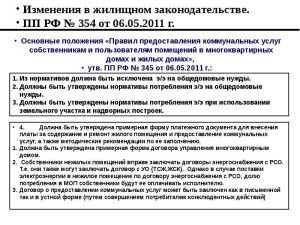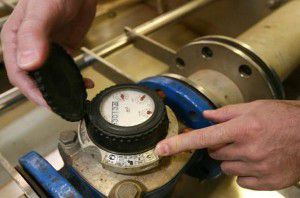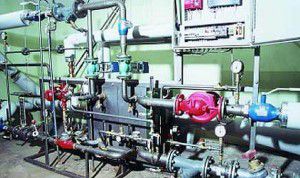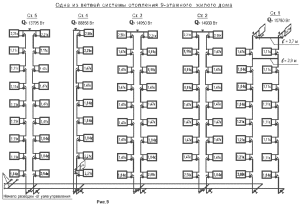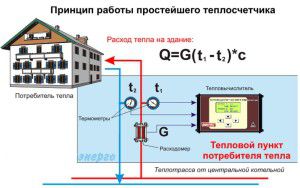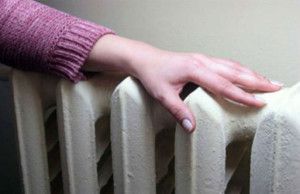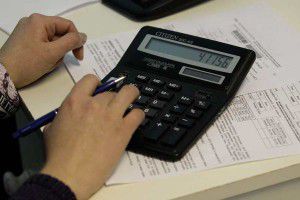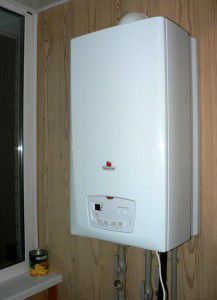Incoming payment receipts for heating services are often baffled by their large amounts payable. In practice, it is very difficult to verify the relevance of these figures, since each management company develops individual tariffs for the population. In this case, you need to know how the payment for heating is carried out: the calculation procedure and calculation.
The legal framework for calculating heating
First of all, it is necessary to find out on what grounds calculations are made for heat supply. To do this, you should study the law on payment for heating. Its latest revision is No. 354 of May 6, 2011. In its paragraphs, the procedure for calculating payment is described in detail.
Compared with the old version, the procedure for calculating the amounts for the services provided, as well as the forms for concluding the contract and receipts, have undergone a change. Before calculating the surcharge for heating, the consumer needs to know the type of arrangement of his apartment building:
- A common house metering device for consumed heat energy has been installed, but none are available in apartments;
- Along with the common house meter, an individual energy meter is installed in the apartment;
- There are no devices in the house to control the amount of heat consumed.
Only after that you can find out how the payment for heating is calculated. In addition, according to the decree No. 354, the payment for the consumed heat energy is divided into two types - for a specific residential premises and as common house needs. The latter include heating stairwells, basements and attics of buildings. Therefore, before calculating the payment for heating, you should find out from the management company the total area of these premises, as well as the tariff for maintaining the desired temperature level in them.
The same information should be displayed in the receipts received - there will be 2 points for payment, which will give the total amount. Typically, the standards for paying for heating non-residential premises are higher than residential. But when dividing the total amount for all apartments in the house, their release in the receipts decreases.
Since payment for heating residential and non-residential premises is considered, it is necessary that this information be spelled out in an agreement with the management company.
Central heating - calculation options
Currently, there are no uniform tariffs according to which payments for housing and communal services for heating would be made. Instead, there are recommendations and rules for the formation of the cost of services by management companies responsible for the heat supply of residential buildings. The calculation method directly depends on the heat meters installed in the house or apartment.
In addition, the climatic features of the region, the degree of wear and tear of the equipment, as well as the insulation of the house, affect the size of the amount. These factors are taken into account while maintaining the desired temperature level in residential and non-residential premises of the building.
| Type of premises | Air heating level, ° С | |
| Optimal | Critical | |
| Room | From 20 to 22 | 18 to 24 |
| Toilet and kitchen | From 19 to 21 | 18 to 26 |
| Bathroom | 24 to 26 | 18 to 26 |
| The corridor | 18 to 20 | From 16 to 22 |
| Landing | From 16 to 18 | From 14 to 20 |
Those. the lower the efficiency of the system - the higher will be the payment for heating all year round. Consider the main options for calculating the cost of heat supply services according to the latest methods, regulated at the legislative level.
In some cases, several heating risers can pass through one apartment.Installing a counter on each of them is a costly undertaking. Then it is best to install a common house heat meter.
Calculation of heating with a common meter
If a heat meter is installed in the house, the management company is obliged to perform calculations according to a certain formula. In this case, the procedure for charging for heating should consist of several points.
First of all, it is necessary to agree on the total area of the building and the specific apartment for which the calculation is performed. Then the following actions are performed:
- Reconciliation of the readings of the common house meter at the beginning and end of the payment period. The difference is the total energy consumption at home. Thus, it is possible to correctly calculate the payment for heating an apartment or non-residential premises;
- Calculate the ratio of the total area of the apartment to the same indicator for the house;
- Find out the tariff for the payment of thermal energy from the management company.
Further calculation of the payment for heating is carried out according to the following formula:
P = V * (Tk / Td) * K
Where R - the planned amount to be paid,V - the amount of thermal energy consumed during the period,Tk and Td - the area of the apartment and house,TO - tariff for heating the apartment.
As an example, you can calculate the payment for heating for an apartment with a total area of 43 m² located in a house with 7000 m². Total heat consumption was 85 Gcal. For Voronezh, the average tariff is 1371 r / Gcal. Then, according to the norms of payment for heating, the total amount will be:
P = 85 * (43/7000) * 1371 = 715 rubles.
But besides this, a system of standards for payment for heating was introduced. It is used in the absence of individual heat meters. The average W rate for residential buildings currently ranges from 0.022 to 0.03 Gcal / m² per month. Then the calculation to consider the payment for heating is necessary according to the following formula:
P = Tk * W * K
Suppose the value of W = 0.027. In this case, the payment will be:
P = 43 * 0.027 * 1371 = 1591 rubles.
It is according to this formula that all management companies prefer to make calculations.
When drawing up a heat supply agreement, it is necessary to check the calculation method. In practice, management companies do not always provide it.
Calculation of heating with a common meter and individual metering devices
A much simpler situation is when the apartment has a heat meter. In this case, you just need to multiply the meter by the tariff of the management company.
Considering that a different interpretation of the law on payment for heating is possible, special attention should be paid to tariffs. The difference in prices between different providers of this service can reach 30%. And even if you pay for heating on an individual meter, a high tariff can nullify all attempts to save on current costs.
But in practice, the consumer does not have the opportunity to choose a management company. This is especially true for apartment buildings. Therefore, when a check calculation is made of the payment for heating with an individual heat meter, current tariffs must be applied.
However, in addition to the cost of services for energy consumption in residential premises, it is necessary to take into account the costs of communal heating. First, the amount of thermal energy spent on this type of heat supply is calculated. To do this, use the formula:
V = N * S * (Tk / Td)
Where V - the share of the owner of the apartment to pay for common heating,N - consumption standards for payment for communal heating,S - the total area of the premises related to this category,Tk and Td - the area of the apartment and house.
Currently, N is 0.016 Gcal / m². For an example of calculating the payment for communal heating, we can assume that the area of non-residential premises in the house is 500 m².Then the owner of the apartment must pay the following heat consumption for their heating:
V = 0.06 * 500 (43/7000) = 0.18 Gcal
Then you need to multiply the result by the tariff from the service provider. In most cases, in the general calculation of the payment for heating, this part takes from 5% to 15%.
To reduce the common house expenses, it is recommended to install a common heating meter. Thanks to this, it is possible to reduce current heating costs from 15% to 30%.
How to reduce current heating costs
Given the constantly rising tariffs for housing and communal services for heating, the issue of reducing these costs becomes more relevant every year. The problem of reducing costs lies in the specifics of the centralized system.
How to reduce the payment for heating and at the same time ensure the proper level of heating of the premises? First of all, you need to learn that for central heating, the usual effective ways to reduce heat loss do not work. Those. if the facade of the house was insulated, the window structures were replaced with new ones - the amount of payment will remain the same.
The only way to reduce heating costs is to install individual heat meters. However, you may encounter the following problems:
- A large number of thermal risers in the apartment. Currently, the average cost of installing a heating meter ranges from 18 to 25 thousand rubles. In order to carry out calculations of the cost of heating for an individual appliance, their installation on each riser is necessary;
- Difficulty in obtaining permission to install the meter. For this, it is necessary to obtain technical specifications and on their basis to select the optimal model of the device;
- In order to make timely payments for heat supply by an individual meter, it is necessary to periodically send them for verification. For this, the dismantling and subsequent installation of the verification device is performed. This also entails additional costs.
But despite these factors, the installation of a heat meter will ultimately lead to a significant reduction in payment for heat supply services. If the house has a circuit with several thermal risers passing through each apartment, you can install a common house meter. In this case, the reduction in costs will not be so significant.
When calculating the payment for heating on a common-house meter, it is not the amount of received thermal energy that is taken into account, but the difference between it and in the return pipe of the system. This is the most acceptable and open way to form the final cost of the service. In addition, by choosing the optimal model of the device, you can further improve the heating system of the house according to the following indicators:
- The ability to regulate the amount of thermal energy consumed in the building, depending on external factors - outdoor temperature;
- A transparent way to calculate your heating bills. However, at the same time, the total amount is distributed over all apartments in the house depending on their area, and not according to the amount of thermal energy that came into each room.
In addition, only representatives of the management company can deal with the maintenance and configuration of the common house meter. However, residents have the right to demand all the necessary reporting to verify the completed and accrued utility bills for heat supply.
In addition to the installation of a heat meter, it is necessary to install a modern mixing unit to regulate the degree of heating of the coolant included in the heating system of the house.
Questions about paying for heating services
In addition to the opacity of the charging procedure for heating, there are still a number of problems associated with district heating.In most cases, they are concluded in the quality of the services provided, the legality of charging year-round payment, as well as methods of calculating payment for electric heating.
Alas, the law on payment for central heating services pays a large part to calculations and possible compensation for low-quality services. Getting the latter is extremely difficult due to paperwork. Consider the main problems of central heating and methods for solving them.
Yearly or seasonal payment for heating services
Over the past five to seven years, a new form of charging the cost of services for district heating has appeared. Paying for heating in the summer has become common practice. But how convenient is it for the consumer and legitimate in terms of legislation?
The problem is that the average consumer cannot choose whether to pay him for heat supply all year round or only during the heating season. The decision on this is made only between the management company and the heat supply organization. In rare cases, it is possible to change the payment schedule in agreement with the HOA or HBC.
What are the features of paying for heating in the summer?
- The inability to verify the relevance of the fee. For its formation, the management company uses many confusing and complex methods;
- Uniform financial burden on the consumer. The cost of heat supply services in summer and winter is always the same. Those. expenses in February will be the same as in August;
- Possibility of making a decision on the seasonal payment of heat supply in the presence of heating meters.
It is because of the last point that residents of apartment buildings prefer to install a common heat meter.
Summing up the total cost of seasonal and year-round payment, you can see that a smaller amount will be in the first case.
Payment of gas and electric heating
Whenever possible, many apartment owners are trying to disconnect from district heating. As an alternative, autonomous systems with gas or electric boilers are made.
In practice, you can encounter many problems in organizing such heat supply systems. The main one is not to pay for electric heating, but to obtain permission for its arrangement. And even after the legitimate installation of equipment, the following difficulties may arise:
- Payment for gas heating will be charged on a common basis. Before this, it is mandatory to install a meter for gas consumption;
- Additionally, you will need to pay for heating associated with the common building. The procedure for calculating it was described above;
- It is impossible to connect the boiler to the central heating system, having previously disconnected from it. This will open the common house circuit.
There is a possibility of savings in the organization of electric heating. It consists in the provision of a preferential tariff by the electricity supplier. But it can be applied only if the house does not have a gas main. If available, the cost of electricity services will be calculated on a common basis.
How else can you save on paying for central heating? One option is to provide benefits or subsidies. However, it has been extremely difficult to obtain them recently. To do this, you need to collect a lot of documents, and confirm your requirements for reducing utility bills, including heat supply.
In the video material you can familiarize yourself with the possible problems of operating a common house heat meter:
